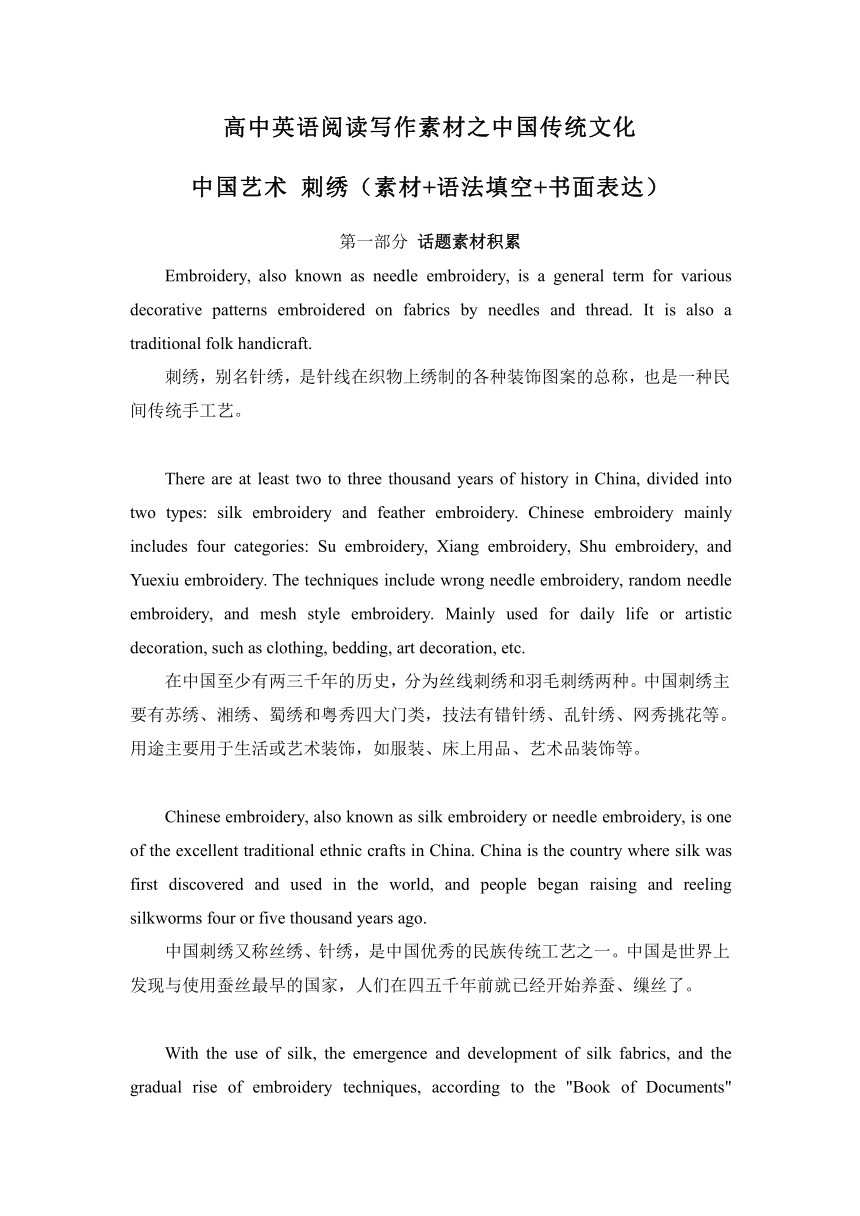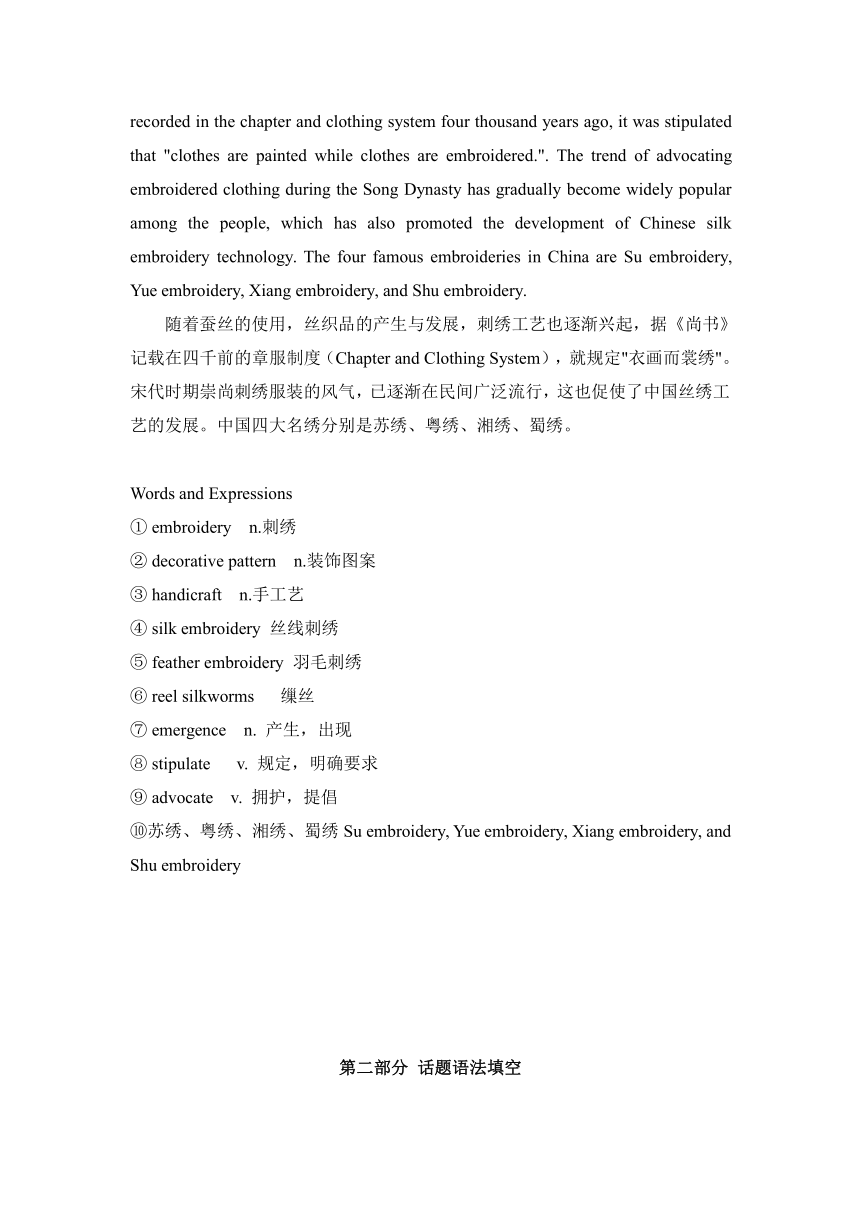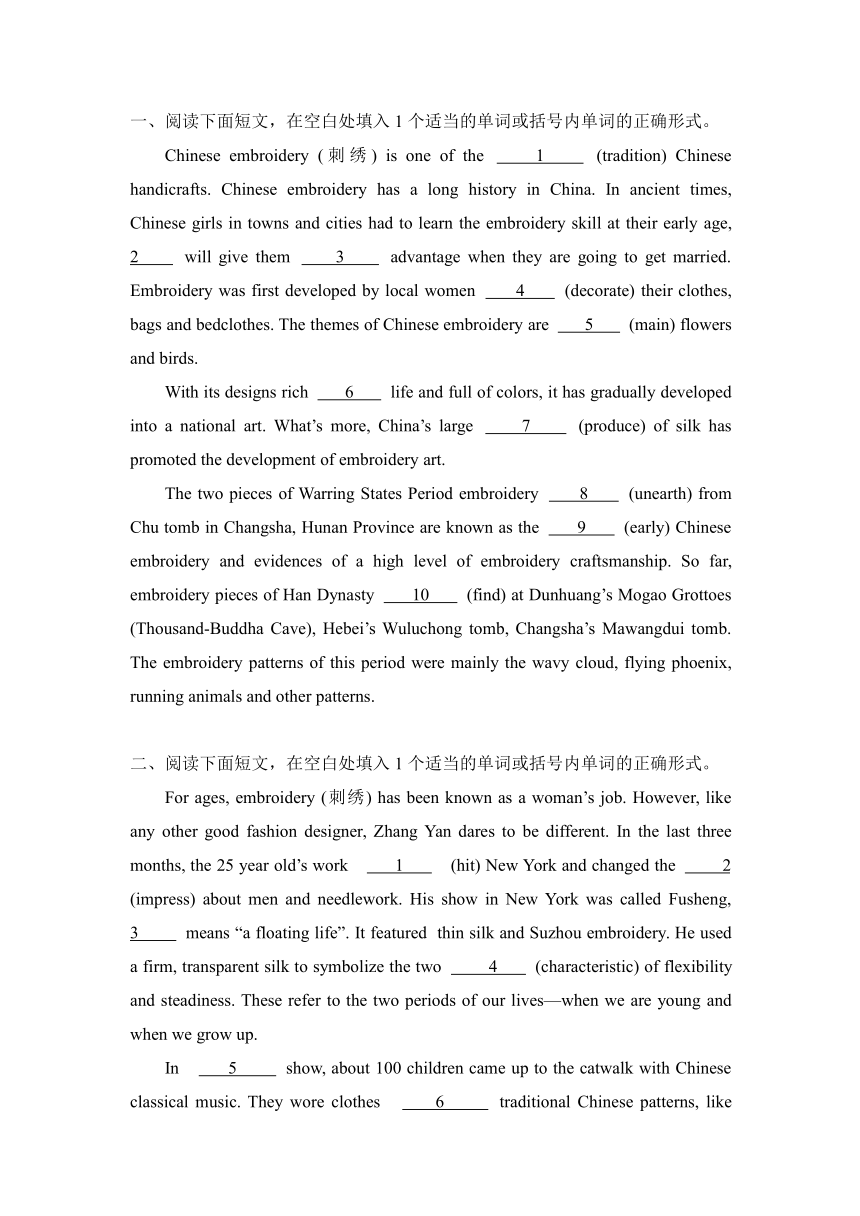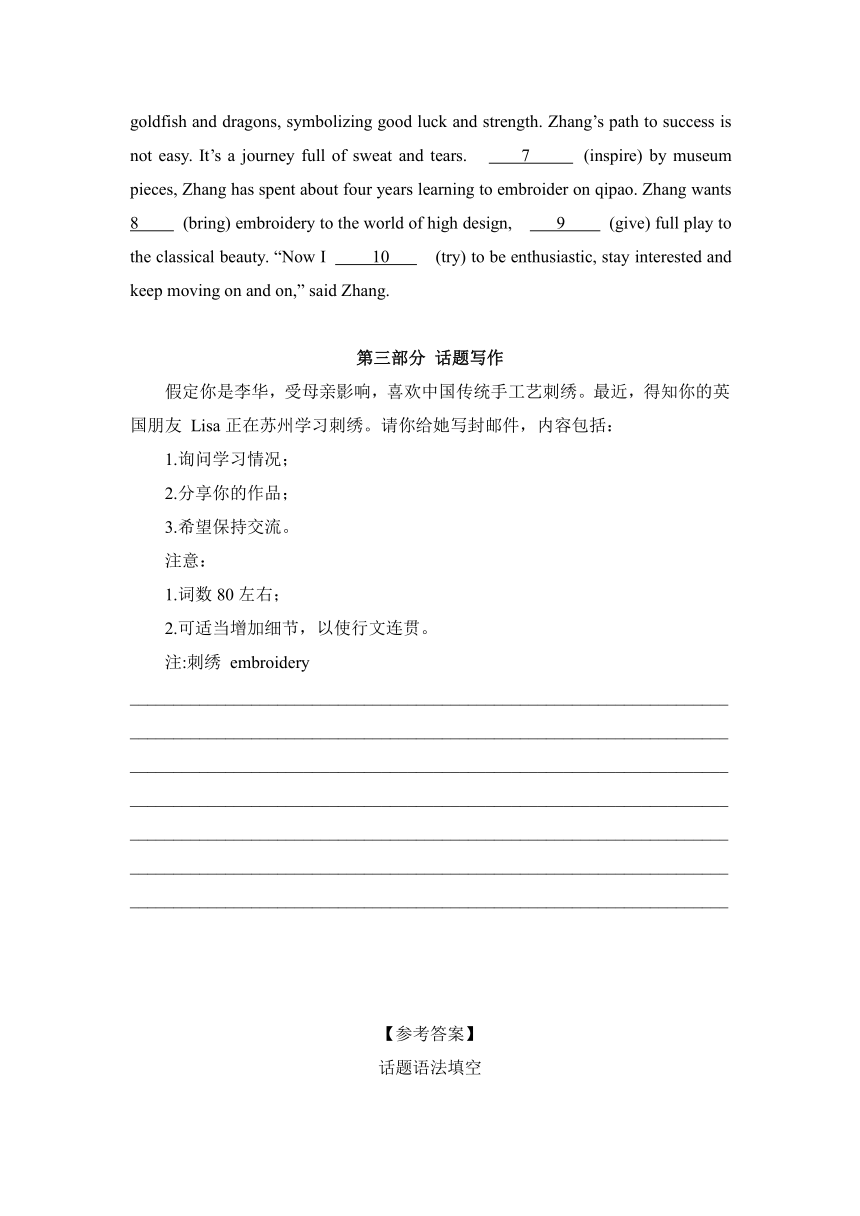2024届高考英语阅读写作素材之中国传统文化专题01 中国艺术 刺绣 (素材+语法填空+书面表达)(含答案)
文档属性
| 名称 | 2024届高考英语阅读写作素材之中国传统文化专题01 中国艺术 刺绣 (素材+语法填空+书面表达)(含答案) |  | |
| 格式 | docx | ||
| 文件大小 | 21.9KB | ||
| 资源类型 | 教案 | ||
| 版本资源 | 通用版 | ||
| 科目 | 英语 | ||
| 更新时间 | 2024-02-28 17:16:30 | ||
图片预览




文档简介
高中英语阅读写作素材之中国传统文化
中国艺术 刺绣(素材+语法填空+书面表达)
话题素材积累
Embroidery, also known as needle embroidery, is a general term for various decorative patterns embroidered on fabrics by needles and thread. It is also a traditional folk handicraft.
刺绣,别名针绣,是针线在织物上绣制的各种装饰图案的总称,也是一种民间传统手工艺。
There are at least two to three thousand years of history in China, divided into two types: silk embroidery and feather embroidery. Chinese embroidery mainly includes four categories: Su embroidery, Xiang embroidery, Shu embroidery, and Yuexiu embroidery. The techniques include wrong needle embroidery, random needle embroidery, and mesh style embroidery. Mainly used for daily life or artistic decoration, such as clothing, bedding, art decoration, etc.
在中国至少有两三千年的历史,分为丝线刺绣和羽毛刺绣两种。中国刺绣主要有苏绣、湘绣、蜀绣和粤秀四大门类,技法有错针绣、乱针绣、网秀挑花等。用途主要用于生活或艺术装饰,如服装、床上用品、艺术品装饰等。
Chinese embroidery, also known as silk embroidery or needle embroidery, is one of the excellent traditional ethnic crafts in China. China is the country where silk was first discovered and used in the world, and people began raising and reeling silkworms four or five thousand years ago.
中国刺绣又称丝绣、针绣,是中国优秀的民族传统工艺之一。中国是世界上发现与使用蚕丝最早的国家,人们在四五千年前就已经开始养蚕、缫丝了。
With the use of silk, the emergence and development of silk fabrics, and the gradual rise of embroidery techniques, according to the "Book of Documents" recorded in the chapter and clothing system four thousand years ago, it was stipulated that "clothes are painted while clothes are embroidered.". The trend of advocating embroidered clothing during the Song Dynasty has gradually become widely popular among the people, which has also promoted the development of Chinese silk embroidery technology. The four famous embroideries in China are Su embroidery, Yue embroidery, Xiang embroidery, and Shu embroidery.
随着蚕丝的使用,丝织品的产生与发展,刺绣工艺也逐渐兴起,据《尚书》记载在四千前的章服制度(Chapter and Clothing System),就规定"衣画而裳绣"。宋代时期崇尚刺绣服装的风气,已逐渐在民间广泛流行,这也促使了中国丝绣工艺的发展。中国四大名绣分别是苏绣、粤绣、湘绣、蜀绣。
Words and Expressions
① embroidery n.刺绣
② decorative pattern n.装饰图案
③ handicraft n.手工艺
④ silk embroidery 丝线刺绣
⑤ feather embroidery 羽毛刺绣
⑥ reel silkworms 缫丝
⑦ emergence n. 产生,出现
⑧ stipulate v. 规定,明确要求
⑨ advocate v. 拥护,提倡
⑩苏绣、粤绣、湘绣、蜀绣Su embroidery, Yue embroidery, Xiang embroidery, and Shu embroidery
第二部分 话题语法填空
一、阅读下面短文,在空白处填入1个适当的单词或括号内单词的正确形式。
Chinese embroidery (刺绣) is one of the 1 (tradition) Chinese handicrafts. Chinese embroidery has a long history in China. In ancient times, Chinese girls in towns and cities had to learn the embroidery skill at their early age, 2 will give them 3 advantage when they are going to get married. Embroidery was first developed by local women 4 (decorate) their clothes, bags and bedclothes. The themes of Chinese embroidery are 5 (main) flowers and birds.
With its designs rich 6 life and full of colors, it has gradually developed into a national art. What’s more, China’s large 7 (produce) of silk has promoted the development of embroidery art.
The two pieces of Warring States Period embroidery 8 (unearth) from Chu tomb in Changsha, Hunan Province are known as the 9 (early) Chinese embroidery and evidences of a high level of embroidery craftsmanship. So far, embroidery pieces of Han Dynasty 10 (find) at Dunhuang’s Mogao Grottoes (Thousand-Buddha Cave), Hebei’s Wuluchong tomb, Changsha’s Mawangdui tomb. The embroidery patterns of this period were mainly the wavy cloud, flying phoenix, running animals and other patterns.
二、阅读下面短文,在空白处填入1个适当的单词或括号内单词的正确形式。
For ages, embroidery (刺绣) has been known as a woman’s job. However, like any other good fashion designer, Zhang Yan dares to be different. In the last three months, the 25 year old’s work 1 (hit) New York and changed the 2 (impress) about men and needlework. His show in New York was called Fusheng, 3 means “a floating life”. It featured thin silk and Suzhou embroidery. He used a firm, transparent silk to symbolize the two 4 (characteristic) of flexibility and steadiness. These refer to the two periods of our lives—when we are young and when we grow up.
In 5 show, about 100 children came up to the catwalk with Chinese classical music. They wore clothes 6 traditional Chinese patterns, like goldfish and dragons, symbolizing good luck and strength. Zhang’s path to success is not easy. It’s a journey full of sweat and tears. 7 (inspire) by museum pieces, Zhang has spent about four years learning to embroider on qipao. Zhang wants 8 (bring) embroidery to the world of high design, 9 (give) full play to the classical beauty. “Now I 10 (try) to be enthusiastic, stay interested and keep moving on and on,” said Zhang.
第三部分 话题写作
假定你是李华,受母亲影响,喜欢中国传统手工艺刺绣。最近,得知你的英国朋友 Lisa正在苏州学习刺绣。请你给她写封邮件,内容包括:
1.询问学习情况;
2.分享你的作品;
3.希望保持交流。
注意:
1.词数80左右;
2.可适当增加细节,以使行文连贯。
注:刺绣 embroidery
___________________________________________________________________________________________________________________________________________________________________________________________________________________________________________________________________________________________________________________________________________________________________________________________________________________________________________________________________________________________________
【参考答案】
话题语法填空
一、
traditional 2.which 3.an 4.to decorate 5.mainly
6.in 7.production 8.unearthed 9.earliest 10.have been found
【导语】本文是一篇说明文。文章主要介绍了中国刺绣的历史和意义。
1.考查形容词。句意:中国刺绣是中国传统手工艺品之一。分析句子结构可知,空处应用形容词traditional“传统的”,在句中作定语修饰名词短语Chinese handicrafts。故填traditional。
2.考查定语从句。句意:在古代,中国的城镇女孩在很小的时候就必须学习刺绣技巧,这会给她们结婚带来优势。分析句子结构可知,空处引导非限制性定语从句,先行词为前面的主句,关系词替代先行词在从句中作主语,用关系代词which。故填which。
3.考查冠词。句意:在古代,中国的城镇女孩在很小的时候就必须学习刺绣技巧,这会给她们结婚带来优势。分析句子结构可知,空处应填不定冠词,在句中泛指“一个”,advantage以元音音素开始,故填不定冠词an。故填an。
4.考查动词不定式。句意:刺绣最早是由当地妇女开发的,用来装饰她们的衣服、袋子和床上用品。动词decorate“装饰”,本句谓语为was developed,故空处为非谓语动词,分析句子可知,应用动词不定式to decorate作目的状语,故填to decorate。
5.考查副词。句意:中国刺绣的主题主要是花鸟。分析句子结构可知,空处填副词mainly“主要地,大多”作状语,修饰are。故填mainly。
6.考查介词。句意:它的设计富有生命色彩,逐渐发展成为一门民族艺术。rich in“富含”为固定短语。故填in。
7.考查名词。句意:此外,中国丝绸的大量生产促进了刺绣艺术的发展。分析句子可知,空处应填名词production“生产”在句中作主语,由has可知,要用名词单数。故填production。
8.考查非谓语。句意:湖南长沙楚墓出土的两件战国刺绣被誉为中国最早的刺绣作品,也是刺绣工艺水平较高的证据。分析句子可知,空处在句中做后置定语,且与被修饰词embroidery构成逻辑上的被动关系,故用过去分词形式。故填unearthed。
9.考查形容词最高级。句意:湖南长沙楚墓出土的两件战国刺绣被誉为中国最早的刺绣作品,也是刺绣工艺水平较高的证据。结合句意和the可知,空处应用形容词最高级earliest“最早的”,在句中作定语,修饰名词短语Chinese embroidery。故填earliest。
10.考查时态语态和主谓一致。迄今为止,在敦煌莫高窟(千佛洞)、河北五路冲墓、长沙马王堆墓等地已发现汉代刺绣作品。根据时间状语So far可知,句子应用现在完成时,主语为复数形式的Embroidery pieces of Han Dynasty,与谓语动词find之间是被动关系,故应用现在完成时的被动语态,助动词用have。故填have been found。
二、
has hit 2.impression 3.which 4.characteristics 5.the
6.with 7.Inspired 8.to bring 9.giving 10.am trying
【导语】这是一篇说明文。主要说明了90后大男孩张彦打破了刻板印象,将刺绣带出国门,让全世界领略刺绣的古典之美。
11.考查时态。句意:在过去的三个月里,这位25岁的设计师的作品风靡了纽约,改变了人们对男人和针线活的印象。根据时间状语In the last three months可知,用现在完成时。名词work为单数,所以谓语动词用has。故填has hit。
12.考查名词。句意:在过去的三个月里,这位25岁的设计师的作品风靡了纽约,改变了人们对男人和针线活的印象。作change的宾语应用名词impression。故填impression。
13.考查定语从句。句意:他在纽约的展览名为“浮生”,意思是“漂浮的生活”。非限制性定语从句修饰先行词Fusheng,在从句作主语,指物,故填which。
14.考查名词的数。句意:他用一种坚固透明的丝绸来象征柔韧性和稳定性这两个特点。根据上文two可知应用名词复数。故填characteristics。
15.考查冠词。句意:在这场秀中,大约100名孩子伴随着中国古典音乐走上t台。此处特指上文“His show in New York was called Fusheng”中的show应用定冠词。故填the。
16.考查介词。句意:他们穿着有中国传统图案的衣服,比如金鱼和龙,象征着好运和力量。此处表示“带有”,后跟名词作宾语,应用介词with。故填with。
17.考查非谓语动词。句意:受到博物馆藏品的启发,张花了四年时间学习刺绣旗袍。分析句子结构可知inspire与逻辑主语Zhang构成被动关系,故用过去分词作状语,首字母大写。故填Inspired。
18.考查非谓语动词。句意:张想把刺绣带到高级设计的世界,充分发挥古典美。短语want to do sth.表示“想要做某事”。故填to bring。
19.考查非谓语动词。句意:张想把刺绣带到高级设计的世界,充分发挥古典美。分析句子结构可知give与逻辑主语Zhang构成主动关系,故用现在分词作状语,故填giving。
20.考查时态。句意:“现在我正努力保持热情,保持兴趣,继续前进,”张说。根据上文now可知正在进行应用现在进行时,故填am trying。
话题写作
One possible version:
Dear Lisa,
It is nice to know you are learning how to do embroidery in Suzhou, for I am also a big fan of this traditional Chinese handicraft. I wonder how you are getting along with your embroider courses.
My mother is credited with arousing my interest in Chinese silk embroidery. Under her guidance, I have just finished one piece of needlework and I’d like to share it with you. If convenient, we can continue learning from each other by sharing our works and communicating regularly.
Hope you can make more progress.
Yours,
Li Hua
【分析】本文为应用文。假定你是李华,受母亲影响,喜欢中国传统手工艺刺绣。最近,得知你的英国朋友 Lisa正在苏州学习刺绣。请你给她写封邮件,内容包括:询问学习情况;分享你的作品;希望保持交流。
【详解】本文为书信体作文。书信体作文分为三个部分,第一部分叙述写邮件的原因,你受母亲影响,喜欢中国传统手工艺刺绣。最近,得知你的英国朋友 Lisa正在苏州学习刺绣。给她写封邮件。第二部分叙述邮件的内容,包括:询问学习情况;分享你的作品;希望保持交流。最后表达自己的期待。注意词数80左右;可适当增加细节,以使行文连贯。同时运用一些顺序连词让整个文章更顺畅,句式也要灵活多变,如运用一些复合句如定语从句,状语从句等。
【点睛】文章内容要点完整,结构合理。句式比较灵活,既有简单句与复杂句结合,如复杂句It is nice to know you are learning how to do embroidery in Suzhou, for I am also a big fan of this traditional Chinese handicraft. I wonder how you are getting along with your embroider courses。还有并列句如Under her guidance, I have just finished one piece of needlework and I’d like to share it with you;省略句如 If convenient, we can continue learning from each other by sharing our works and communicating regularly;以及宾语从句如Hope you can make more progress。
中国艺术 刺绣(素材+语法填空+书面表达)
话题素材积累
Embroidery, also known as needle embroidery, is a general term for various decorative patterns embroidered on fabrics by needles and thread. It is also a traditional folk handicraft.
刺绣,别名针绣,是针线在织物上绣制的各种装饰图案的总称,也是一种民间传统手工艺。
There are at least two to three thousand years of history in China, divided into two types: silk embroidery and feather embroidery. Chinese embroidery mainly includes four categories: Su embroidery, Xiang embroidery, Shu embroidery, and Yuexiu embroidery. The techniques include wrong needle embroidery, random needle embroidery, and mesh style embroidery. Mainly used for daily life or artistic decoration, such as clothing, bedding, art decoration, etc.
在中国至少有两三千年的历史,分为丝线刺绣和羽毛刺绣两种。中国刺绣主要有苏绣、湘绣、蜀绣和粤秀四大门类,技法有错针绣、乱针绣、网秀挑花等。用途主要用于生活或艺术装饰,如服装、床上用品、艺术品装饰等。
Chinese embroidery, also known as silk embroidery or needle embroidery, is one of the excellent traditional ethnic crafts in China. China is the country where silk was first discovered and used in the world, and people began raising and reeling silkworms four or five thousand years ago.
中国刺绣又称丝绣、针绣,是中国优秀的民族传统工艺之一。中国是世界上发现与使用蚕丝最早的国家,人们在四五千年前就已经开始养蚕、缫丝了。
With the use of silk, the emergence and development of silk fabrics, and the gradual rise of embroidery techniques, according to the "Book of Documents" recorded in the chapter and clothing system four thousand years ago, it was stipulated that "clothes are painted while clothes are embroidered.". The trend of advocating embroidered clothing during the Song Dynasty has gradually become widely popular among the people, which has also promoted the development of Chinese silk embroidery technology. The four famous embroideries in China are Su embroidery, Yue embroidery, Xiang embroidery, and Shu embroidery.
随着蚕丝的使用,丝织品的产生与发展,刺绣工艺也逐渐兴起,据《尚书》记载在四千前的章服制度(Chapter and Clothing System),就规定"衣画而裳绣"。宋代时期崇尚刺绣服装的风气,已逐渐在民间广泛流行,这也促使了中国丝绣工艺的发展。中国四大名绣分别是苏绣、粤绣、湘绣、蜀绣。
Words and Expressions
① embroidery n.刺绣
② decorative pattern n.装饰图案
③ handicraft n.手工艺
④ silk embroidery 丝线刺绣
⑤ feather embroidery 羽毛刺绣
⑥ reel silkworms 缫丝
⑦ emergence n. 产生,出现
⑧ stipulate v. 规定,明确要求
⑨ advocate v. 拥护,提倡
⑩苏绣、粤绣、湘绣、蜀绣Su embroidery, Yue embroidery, Xiang embroidery, and Shu embroidery
第二部分 话题语法填空
一、阅读下面短文,在空白处填入1个适当的单词或括号内单词的正确形式。
Chinese embroidery (刺绣) is one of the 1 (tradition) Chinese handicrafts. Chinese embroidery has a long history in China. In ancient times, Chinese girls in towns and cities had to learn the embroidery skill at their early age, 2 will give them 3 advantage when they are going to get married. Embroidery was first developed by local women 4 (decorate) their clothes, bags and bedclothes. The themes of Chinese embroidery are 5 (main) flowers and birds.
With its designs rich 6 life and full of colors, it has gradually developed into a national art. What’s more, China’s large 7 (produce) of silk has promoted the development of embroidery art.
The two pieces of Warring States Period embroidery 8 (unearth) from Chu tomb in Changsha, Hunan Province are known as the 9 (early) Chinese embroidery and evidences of a high level of embroidery craftsmanship. So far, embroidery pieces of Han Dynasty 10 (find) at Dunhuang’s Mogao Grottoes (Thousand-Buddha Cave), Hebei’s Wuluchong tomb, Changsha’s Mawangdui tomb. The embroidery patterns of this period were mainly the wavy cloud, flying phoenix, running animals and other patterns.
二、阅读下面短文,在空白处填入1个适当的单词或括号内单词的正确形式。
For ages, embroidery (刺绣) has been known as a woman’s job. However, like any other good fashion designer, Zhang Yan dares to be different. In the last three months, the 25 year old’s work 1 (hit) New York and changed the 2 (impress) about men and needlework. His show in New York was called Fusheng, 3 means “a floating life”. It featured thin silk and Suzhou embroidery. He used a firm, transparent silk to symbolize the two 4 (characteristic) of flexibility and steadiness. These refer to the two periods of our lives—when we are young and when we grow up.
In 5 show, about 100 children came up to the catwalk with Chinese classical music. They wore clothes 6 traditional Chinese patterns, like goldfish and dragons, symbolizing good luck and strength. Zhang’s path to success is not easy. It’s a journey full of sweat and tears. 7 (inspire) by museum pieces, Zhang has spent about four years learning to embroider on qipao. Zhang wants 8 (bring) embroidery to the world of high design, 9 (give) full play to the classical beauty. “Now I 10 (try) to be enthusiastic, stay interested and keep moving on and on,” said Zhang.
第三部分 话题写作
假定你是李华,受母亲影响,喜欢中国传统手工艺刺绣。最近,得知你的英国朋友 Lisa正在苏州学习刺绣。请你给她写封邮件,内容包括:
1.询问学习情况;
2.分享你的作品;
3.希望保持交流。
注意:
1.词数80左右;
2.可适当增加细节,以使行文连贯。
注:刺绣 embroidery
___________________________________________________________________________________________________________________________________________________________________________________________________________________________________________________________________________________________________________________________________________________________________________________________________________________________________________________________________________________________________
【参考答案】
话题语法填空
一、
traditional 2.which 3.an 4.to decorate 5.mainly
6.in 7.production 8.unearthed 9.earliest 10.have been found
【导语】本文是一篇说明文。文章主要介绍了中国刺绣的历史和意义。
1.考查形容词。句意:中国刺绣是中国传统手工艺品之一。分析句子结构可知,空处应用形容词traditional“传统的”,在句中作定语修饰名词短语Chinese handicrafts。故填traditional。
2.考查定语从句。句意:在古代,中国的城镇女孩在很小的时候就必须学习刺绣技巧,这会给她们结婚带来优势。分析句子结构可知,空处引导非限制性定语从句,先行词为前面的主句,关系词替代先行词在从句中作主语,用关系代词which。故填which。
3.考查冠词。句意:在古代,中国的城镇女孩在很小的时候就必须学习刺绣技巧,这会给她们结婚带来优势。分析句子结构可知,空处应填不定冠词,在句中泛指“一个”,advantage以元音音素开始,故填不定冠词an。故填an。
4.考查动词不定式。句意:刺绣最早是由当地妇女开发的,用来装饰她们的衣服、袋子和床上用品。动词decorate“装饰”,本句谓语为was developed,故空处为非谓语动词,分析句子可知,应用动词不定式to decorate作目的状语,故填to decorate。
5.考查副词。句意:中国刺绣的主题主要是花鸟。分析句子结构可知,空处填副词mainly“主要地,大多”作状语,修饰are。故填mainly。
6.考查介词。句意:它的设计富有生命色彩,逐渐发展成为一门民族艺术。rich in“富含”为固定短语。故填in。
7.考查名词。句意:此外,中国丝绸的大量生产促进了刺绣艺术的发展。分析句子可知,空处应填名词production“生产”在句中作主语,由has可知,要用名词单数。故填production。
8.考查非谓语。句意:湖南长沙楚墓出土的两件战国刺绣被誉为中国最早的刺绣作品,也是刺绣工艺水平较高的证据。分析句子可知,空处在句中做后置定语,且与被修饰词embroidery构成逻辑上的被动关系,故用过去分词形式。故填unearthed。
9.考查形容词最高级。句意:湖南长沙楚墓出土的两件战国刺绣被誉为中国最早的刺绣作品,也是刺绣工艺水平较高的证据。结合句意和the可知,空处应用形容词最高级earliest“最早的”,在句中作定语,修饰名词短语Chinese embroidery。故填earliest。
10.考查时态语态和主谓一致。迄今为止,在敦煌莫高窟(千佛洞)、河北五路冲墓、长沙马王堆墓等地已发现汉代刺绣作品。根据时间状语So far可知,句子应用现在完成时,主语为复数形式的Embroidery pieces of Han Dynasty,与谓语动词find之间是被动关系,故应用现在完成时的被动语态,助动词用have。故填have been found。
二、
has hit 2.impression 3.which 4.characteristics 5.the
6.with 7.Inspired 8.to bring 9.giving 10.am trying
【导语】这是一篇说明文。主要说明了90后大男孩张彦打破了刻板印象,将刺绣带出国门,让全世界领略刺绣的古典之美。
11.考查时态。句意:在过去的三个月里,这位25岁的设计师的作品风靡了纽约,改变了人们对男人和针线活的印象。根据时间状语In the last three months可知,用现在完成时。名词work为单数,所以谓语动词用has。故填has hit。
12.考查名词。句意:在过去的三个月里,这位25岁的设计师的作品风靡了纽约,改变了人们对男人和针线活的印象。作change的宾语应用名词impression。故填impression。
13.考查定语从句。句意:他在纽约的展览名为“浮生”,意思是“漂浮的生活”。非限制性定语从句修饰先行词Fusheng,在从句作主语,指物,故填which。
14.考查名词的数。句意:他用一种坚固透明的丝绸来象征柔韧性和稳定性这两个特点。根据上文two可知应用名词复数。故填characteristics。
15.考查冠词。句意:在这场秀中,大约100名孩子伴随着中国古典音乐走上t台。此处特指上文“His show in New York was called Fusheng”中的show应用定冠词。故填the。
16.考查介词。句意:他们穿着有中国传统图案的衣服,比如金鱼和龙,象征着好运和力量。此处表示“带有”,后跟名词作宾语,应用介词with。故填with。
17.考查非谓语动词。句意:受到博物馆藏品的启发,张花了四年时间学习刺绣旗袍。分析句子结构可知inspire与逻辑主语Zhang构成被动关系,故用过去分词作状语,首字母大写。故填Inspired。
18.考查非谓语动词。句意:张想把刺绣带到高级设计的世界,充分发挥古典美。短语want to do sth.表示“想要做某事”。故填to bring。
19.考查非谓语动词。句意:张想把刺绣带到高级设计的世界,充分发挥古典美。分析句子结构可知give与逻辑主语Zhang构成主动关系,故用现在分词作状语,故填giving。
20.考查时态。句意:“现在我正努力保持热情,保持兴趣,继续前进,”张说。根据上文now可知正在进行应用现在进行时,故填am trying。
话题写作
One possible version:
Dear Lisa,
It is nice to know you are learning how to do embroidery in Suzhou, for I am also a big fan of this traditional Chinese handicraft. I wonder how you are getting along with your embroider courses.
My mother is credited with arousing my interest in Chinese silk embroidery. Under her guidance, I have just finished one piece of needlework and I’d like to share it with you. If convenient, we can continue learning from each other by sharing our works and communicating regularly.
Hope you can make more progress.
Yours,
Li Hua
【分析】本文为应用文。假定你是李华,受母亲影响,喜欢中国传统手工艺刺绣。最近,得知你的英国朋友 Lisa正在苏州学习刺绣。请你给她写封邮件,内容包括:询问学习情况;分享你的作品;希望保持交流。
【详解】本文为书信体作文。书信体作文分为三个部分,第一部分叙述写邮件的原因,你受母亲影响,喜欢中国传统手工艺刺绣。最近,得知你的英国朋友 Lisa正在苏州学习刺绣。给她写封邮件。第二部分叙述邮件的内容,包括:询问学习情况;分享你的作品;希望保持交流。最后表达自己的期待。注意词数80左右;可适当增加细节,以使行文连贯。同时运用一些顺序连词让整个文章更顺畅,句式也要灵活多变,如运用一些复合句如定语从句,状语从句等。
【点睛】文章内容要点完整,结构合理。句式比较灵活,既有简单句与复杂句结合,如复杂句It is nice to know you are learning how to do embroidery in Suzhou, for I am also a big fan of this traditional Chinese handicraft. I wonder how you are getting along with your embroider courses。还有并列句如Under her guidance, I have just finished one piece of needlework and I’d like to share it with you;省略句如 If convenient, we can continue learning from each other by sharing our works and communicating regularly;以及宾语从句如Hope you can make more progress。
